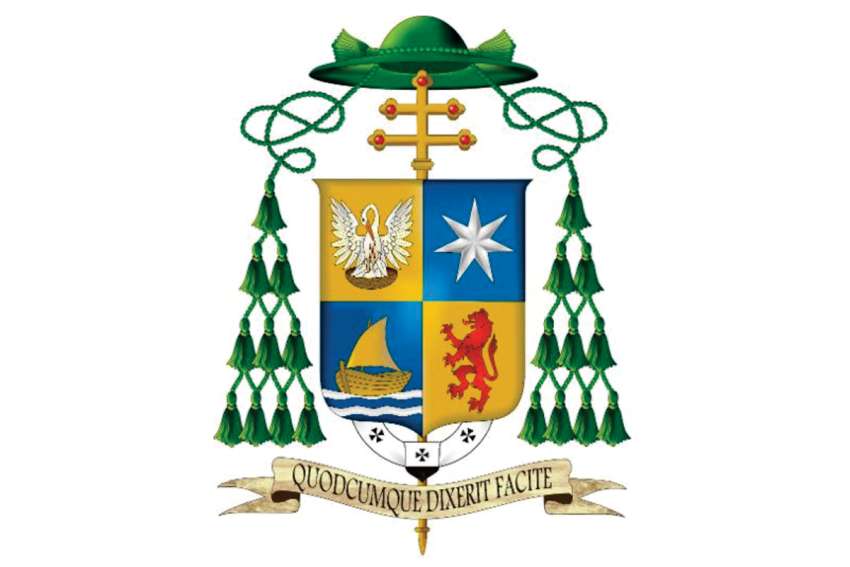According to the Gospel writer, it is the first miracle performed by Jesus and, it should be emphasized, takes place at the request of the Blessed Virgin Mary, a vital detail which underscores the importance of Our Lady in the life and ministry of Christ Himself, an importance that will be codified with Jesus’ final words on the Cross, addressed to her and to the Beloved Disciple, making her the universal Mother and specifically Mother of the Church.
The motto underscores the Virgin Mother’s role of intercessor for the needs of Christ’s disciples. These are likewise the last recorded words of Mother Mary in the Gospels — a sort of spiritual testament.
This Johannine passage is thus dense with rich symbolism, impactful and important signs that underscore multiple aspects of the Catholic faith.
Archbishop Leo’s coat of arms is drawn from four principal aspects and devotions of his life and ministry, and is depicted on the shield in four quarters.
In the upper left (dexter chief) is found one of the most widespread Christological and Eucharistic symbols in Christian iconography: the pelican depicted opening its own flesh with its beak to feed its young with the blood that flows from it. This symbol refers to Christ Himself as being the “Pie pellicane,” words found in the Adoro Te Devote, an ancient Eucharistic hymn attributed to St. Thomas Aquinas: “O loving Pelican, Jesus Lord, unclean though I am, but cleanse me in your blood. One drop of which can free the entire world of all its sins.”
It speaks of Christ shedding His own blood for all of humanity and how He continues to nourish us with His own flesh and blood in the Holy Mass.
A seven-point star is found on the upper right (sinister chief) and is the traditional and well-known Marian symbol par excellence. It refers to the invocation of the Loreto.
The Morning Star is a sign of the coming day, preceding the rising sun. It is a promise of light, announcing the coming of the “sun of Virgin Mary as the Morning Star or “Stella matutina” found in the Litany of justice” (Malachi 4:1-3), the “daybreak from on high visiting us” (Luke 1:78).
We know that the Blessed Mother is the Morning Star not for and through herself; she is indeed the reflection of God, her Creator and Redeemer. She exalts His glory and points to His light and salvation.
The Blessed Mother is called the Star of the New Evangelization, which means she inspires and guides the Churc’sh apostolic efforts in bringing the Gospel to all peoples. The star is in silver (“argent”), a colour which depicts an array of heavenly attributes, personified in Our Lady’s purity, mercy and love.
Archbishop Leo entrusts his life, vocation and new pastoral ministry to her maternal mediation and intercession.
On the lower right (dexter base) is a boat floating on the waves and navigating amid the tempests. This is a well-known and clear reference to the Catholic Church established by Jesus Christ, the barque of St. Peter. It is an ancient Christian symbol and reminds one of the struggles the Church endures, tossed about by raging winds, amid storms on the many rough seas of darkness and persecution but remaining set on its course and mission to bring to the harbour of salvation all of the travellers.
Biblically, the imagery finds its origins in Noah’s Ark in the deluge (Genesis and 1 Peter 3:20-21), and more clearly in the Gospel scene of Jesus protecting the boat of St. Peter with Him and the other apostles amid the stormy sea of Galilee (cf. Mark 4:35-41).
The depiction of a lion is found on the lower right (sinister base) and is meant to recall the Archbishop’s surname, Leo, which is Latin for lion. The lion is depicted as rampant, meaning “on its hind legs,” with the head in profile. Biblically, the lion is a symbol of courage, power and strength, the victory of God (cf. Genesis 49:9-10; Revelation 4:7). The lion is the emblem of dignity, of a powerful and fearless ruler, of majesty and strong leadership.
It is likewise an image of Christ, the King of Kings.
Finally, there is an ancient belief that lion cubs were born dead and after three days were brought to life by their father’s roar. The lion is in red, the colour of blood and also of charity, a reminder of the ardent and infinite love of the Father who sent to us His Only Begotten Son and who shed His blood for our redemption and for the forgiveness of sins. It signifies also that the virtue of charity is key and an integral part for the pastoral zeal of the new Bishop, as a successor to the Twelve Apostles of Jesus Christ.
Blue is the colour symbolizing the incorruptibility of the heavenly vault, of the ideals that rise upward, and represents detachment from the earthly and passing, and the soul’s ascent toward God.
The colour gold, the first among the “noble” metals (those resistant to corrosion), is symbolic of the first virtue: faith. For it is through faith that we can fully understand the love and salvation that the eternal and loving Father offers to all of us, His beloved children in Christ Jesus.

